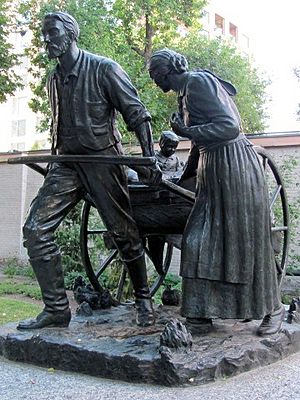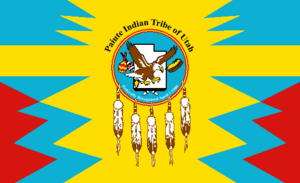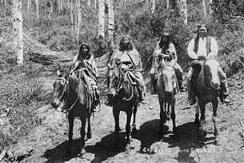Native Americans in Utah facts for kids
Indigenous peoples have lived in the area now known as the state of Utah for thousands of years. Today, five main groups call Utah home: the Utes, Goshutes, Paiutes, Shoshone, and Navajo. Each group lives in a different part of the state. Many of their lands also stretch into neighboring states. In 2010, about 32,927 American Indian and Alaska Natives lived in Utah. This was about 1.19% of Utah's total population.
Contents
Utah's Earliest Residents
People have lived in Utah for a very long time. Evidence shows they were here as far back as 10,000 years ago. They lived in places like the Escalante Valley in Southern Utah. They also lived near the Great Basin, close to the Utah/Nevada border.
The earliest time in Utah's human history is called the Paleoachaic period. This period dates back 11,000 years. We know little about these early people. They relied on wild foods to survive. Hunters caught deer, beaver, and marmots. They also hunted birds like ducks and turkeys. Different tools helped them catch their prey. After a successful hunt, they dried and saved the meat. Men usually did the hunting. Women looked for plants and prepared them. Sometimes, women also hunted small animals.
Farming became popular around the first few centuries A.D. It continued until about A.D. 1300. People grew corn, beans, and squash. They still hunted and gathered food too. During this time, trade became very important. The Fremont culture and the Anasazi people traded with each other. We learn a lot about these ancient people from archaeology. But their written history only began after Europeans arrived in the 1700s.
European Settlers Arrive
Spanish Explorers in Utah
Spain once claimed most of western Utah. This was before the United States expanded westward. In 1765, Juan Maria Antonia Rivera and his group explored parts of Utah. They might have been the first Euro-Americans to do so. Eleven years later, Dominguez and Escalante traveled through Utah. This became a famous journey. The Spanish "claimed" the land. However, many more Indigenous peoples lived there than Spanish explorers.
Fur Trappers and Traders
For about 85 years, mostly fur trappers and traders came through Utah. Jedediah Smith and Jim Bridger were among the first. Later, Peter Skene Ogden, Miles Goodyear, and Etienne Provost followed. Relations between trappers and Native peoples varied. Some were friendly, others were not. Over time, trappers learned to communicate better. First, they used signs. Later, some learned Native languages. Some even married Native women.
Mormon Pioneers Settle Utah
July 24, 1847, is a special day in Utah. It's when the Mormon Pioneers entered the Salt Lake Valley. This day is now a holiday called Pioneer Day. But when the pioneers arrived, the land was not empty. It's thought that about 20,000 Native Americans already lived in what is now Utah.
For the first few years, relations were mostly peaceful. Some trading happened. As pioneers settled more land beyond the Salt Lake Valley, Native Americans lost their homes. Tensions began to grow. Most disagreements were solved peacefully. But this was the start of harder times. In 1853, the Walker War began. Then, the Black Hawk War followed in 1865. By the 1870s, the government started to have more organized policies. This led to fewer personal fights between Native peoples and settlers. This period of new policies lasted for about 100 years. It affected Native Americans in Utah and across the country.
Native Americans Today
Education for Native American Youth
Since 1900, many Native American children have gone to public schools. The government wanted Native Americans to join white culture. They hoped public schools would help them leave their own culture behind. Many white Utah residents did not like this idea. Some teachers were openly against it. This made school hard for Native American students. Some hostility was because Native Americans on reservations did not pay school taxes. There were stories of bus drivers not picking up Native American students. Racism was a problem in schools. This issue continued until the Indian Education Act of 1972. This law helped some Native American children. But many had already left school before it passed.
Government and Self-Rule
The history of Native American self-rule has changed over time. 1. Before Europeans, Native Americans had their own cultures and governments. 2. Then, they were moved onto reservations. 3. Next, government policies tried to make them join white culture. 4. Today, Native Americans are working to gain more control over their own lands and lives.
This long history has caused confusion. People wonder about the difference between Native American self-rule and the federal government's power. Native American tribes were once seen as separate nations. They had the right to make treaties. They could govern their own land as they wished. But the push to make them join white culture tried to take away these powers.
Regarding land rights, lands in Utah set aside for Native Americans are protected. They are "reserved from settlement, entry, sale, or other disposition." They are for the use and benefit of the Goshute and other Indigenous peoples in Utah.
A recent law, the 1975 Indian Self Determination and Education Assistance Act, was important. It gave tribes more freedom to govern themselves. They can now manage federal programs. They also have more control over their own resources.
Indian Reservations in Utah
Indian Reservations are special places for Indigenous people to live. These places are run by the government of a specific Indigenous Nation. They are not run by the state governments of the United States of America.
Federally recognized tribes govern the reservations. These tribes have a government-to-government relationship with the United States. This is like the relationship the U.S. has with other countries.
In Utah, one reservation is the Skull Valley Reservation. It is in Tooele County, Utah. The Goshute people are the recognized tribe there. Another is the Uintah and Ouray Indian Reservation. The Ute tribe governs this land. It is the second-largest reservation in the U.S. It spans several counties in Utah. However, not all Indigenous people in Utah live on reservations. About 46% live in urban Salt Lake City. Many also live in Weber, Utah, and Davis counties. Most of the remaining 54% live on the reservations.
Native American Cultures in Utah
Ute People
The Ute people are native to Utah and nearby states. These include Arizona, Colorado, Nevada, New Mexico, and Wyoming. They speak a language called Shoshonean. They are ancestors of the Uto-Aztecs. Today, the Ute people are divided into groups called bands. These bands include The Mouache, The Caputa, The Weenuchiu, The White River Ute, and The Pahvant.
The Ute people used many ways to find food. They gathered food from wild plants. Men usually hunted larger animals. Women trapped smaller animals. Some Ute bands began to farm. Others learned how to use plants for medicine.
Goshute People
The Goshute people are native to the Desert Region of the Great Salt Lake Desert in Utah. They were very good at hunting and gathering in this desert area. In their traditions, they believe they have always lived there. Living in the desert helped the Goshutes. White settlers did not bother them much until the mid-1800s. When Mormon settlers arrived, the Goshutes were pushed out of their land.
Paiute People
The Paiute people are native to Utah. They were a nomadic people, meaning they moved around often. Their original land covered 30 million acres. They moved with the seasons and animal migrations. Paiutes were mostly left alone by European settlers until the 1850s. That's when Mormon settlers came to their land. A well-known event was the Mountain Meadows Massacre in 1857. The Paiute people have always said they were not involved. At the time, Mormons blamed them.
Shoshone People
The Shoshone people are native to Wyoming, Idaho, and Utah. The name Shoshone means "high growing grasses." They are sometimes called the "Grass House People." The Shoshone people are native to the Great Basin area. They were mainly hunters and gatherers. Bison meat was their most important food source.
The Navajo are native to the southwestern states. These include New Mexico, Arizona, Utah, and Colorado. They are the second-largest federally recognized tribe in the U.S. About 300,000 people are enrolled as Navajo. The Navajo people were mostly hunters and gatherers. But they later learned farming techniques. The Navajo people originally lived in areas that are now part of Mexico. When Spanish explorers arrived, they were pushed back to Southern Utah and other southwest states.




